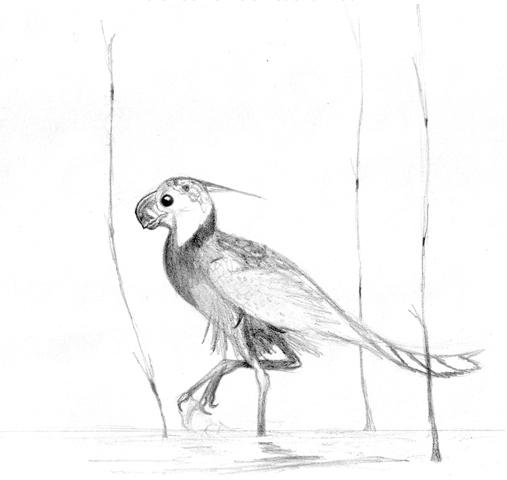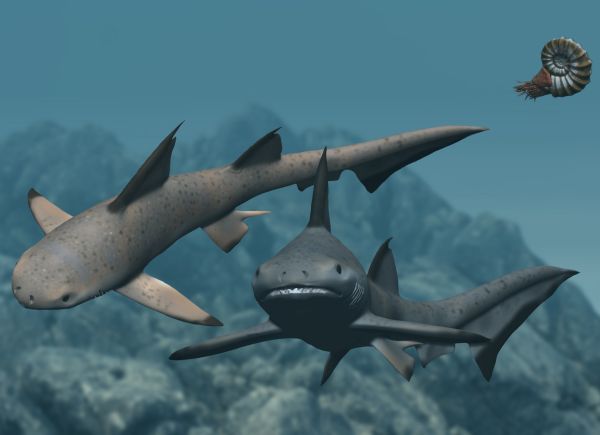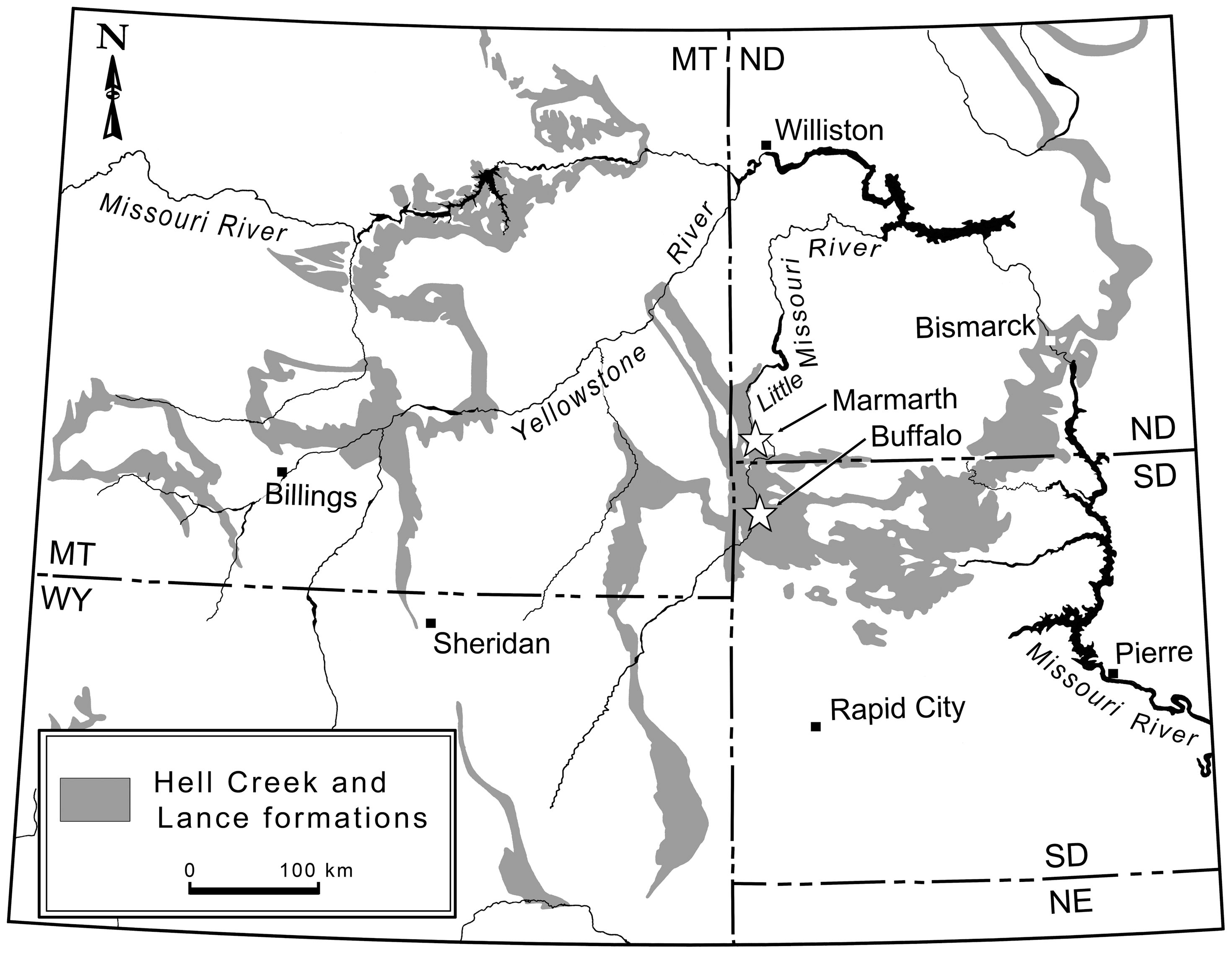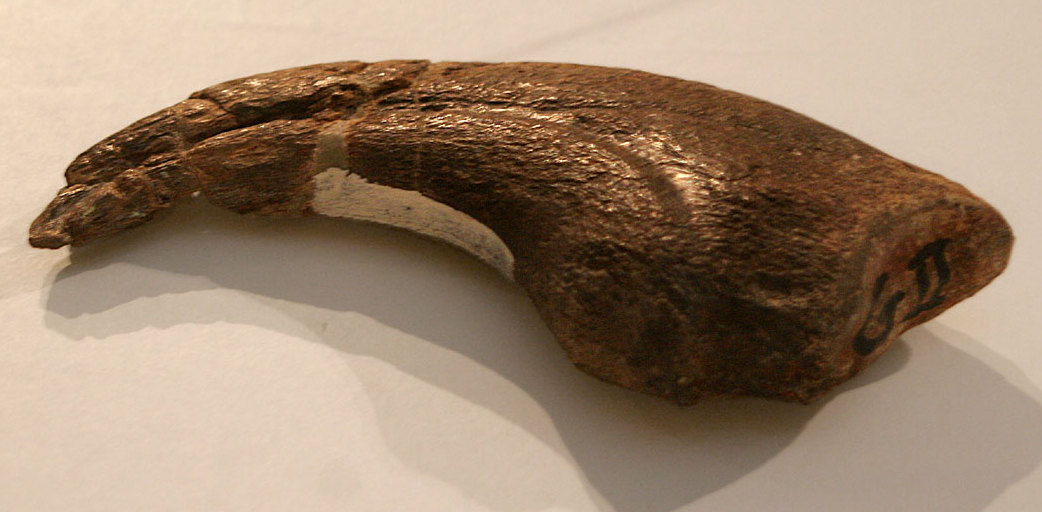|
Caenagnathasia Martinsoni
''Caenagnathasia'' ('recent jaw from Asia') is a small caenagnathid oviraptorosaurian theropod from the Late Cretaceous of Uzbekistan. Discovery The type species ''Caenagnathasia martinsoni'' was named and described in 1994 by Philip J. Currie, Stephen Godfrey and Lev Nesov. The generic name is a combination of a reference to the species' placement in the Caenagnathidae, with Asia, the continent of its provenance. The specific name honours Gerbert Genrikhovich Martinson. The genus is based on holotype N 401/12457, a pair of fused dentaries of the lower jaws. The specimen was found near Dzharakuduk in layers of the Bissekty Formation, dating to the Turonian-Coniacian, around 90 mya, making it the oldest known caenagnathoid. A second specimen was referred to the species, N 402/12457, a right dentary of a slightly smaller individual. Both individuals were adult. In 2015, new material of ''Caenagnathasia'' was described. From the same site as the holotype, the material ... [...More Info...] [...Related Items...] OR: [Wikipedia] [Google] [Baidu] |
Turonian
The Turonian is, in the ICS' geologic timescale, the second age in the Late Cretaceous Epoch, or a stage in the Upper Cretaceous Series. It spans the time between 93.9 ± 0.8 Ma and 89.8 ± 1 Ma (million years ago). The Turonian is preceded by the Cenomanian Stage and underlies the Coniacian Stage. At the beginning of the Turonian an oceanic anoxic event (OAE 2) took place, also referred to as the Cenomanian-Turonian boundary event or the "Bonarelli Event". Stratigraphic definition The Turonian (French: ''Turonien'') was defined by the French paleontologist Alcide d'Orbigny (1802–1857) in 1842. Orbigny named it after the French city of Tours in the region of Touraine (department Indre-et-Loire), which is the original type locality. The base of the Turonian Stage is defined as the place where the ammonite species '' Watinoceras devonense'' first appears in the stratigraphic column. The official reference profile (the GSSP) for the base of the Turonian is located in the Roc ... [...More Info...] [...Related Items...] OR: [Wikipedia] [Google] [Baidu] |
Bissekty Formation
The Bissekty Formation (sometimes referred to as Bissekt) is a geologic formation and Lagerstätte which crops out in the Kyzyl Kum desert of Uzbekistan, and dates to the Late Cretaceous Period. Laid down in the mid to late Turonian, it is dated to about 92 to 90 Ma (million years ago). Description The lithology of the sediment largely consists of cross bedded sandstones with interbeds of massive sandstone, well cemented intraformational conglomerate, siltstones and mudstones. Most of the fossils are found as clasts within the conglomerates. Fossil content The Bissekty Formation is characterised by a mix of marine, brackish, freshwater, and terrestrial animal fossils. This stands in contrast the strictly marine fossils found in the underlying Dzheirantui Formation, and indicates that the Bissekty was formed during the regression of a saltwater sea. The coastline expanded inland again in the upper portion of the Bissekty, represented by a proportional increase of fully aquat ... [...More Info...] [...Related Items...] OR: [Wikipedia] [Google] [Baidu] |
Anzu Wyliei
''Anzu'' (named for Anzû, a bird-like daemon in Ancient Mesopotamian religion) is a monospecific genus of caenagnathid dinosaur from North Dakota, South Dakota and Montana that lived during the Late Cretaceous (upper Maastrichtian stage, 67.2-66.0 Ma) in what is now the Hell Creek Formation. The type species and only species, ''Anzu wyliei'' is known from numerous skeletons that preserve cranial and postcranial elements. It was named in 2014 by Matthew C. Lamanna, Hans-Dieter Sues, Emma R. Schachner, and Tyler R. Lyson. It was named one of the "Top 10 New Species" for new species discovered in 2014 by the International Institute for Species Exploration in 2015. History of discovery Several large skeletons from the late Maastrichtian Hell Creek Formation of Montana and South Dakota were initially referred to as "cf. ''Chirostenotes''",Varricchio, D. J. (2001). Late Cretaceous Oviraptorosaur (Theropoda) dinosaurs from Montana. ''Mesozoic Vertebrate Life.'' D. H. Tanke and K. ... [...More Info...] [...Related Items...] OR: [Wikipedia] [Google] [Baidu] |
Leptorhynchos (dinosaur)
''Leptorhynchos'' (meaning "slender beak") is an extinct genus of caenagnathid dinosaurs known from the Late Cretaceous (Campanian-Maastrichtian aged) Aguja Formation of west Texas United States. It lived about 80.5–72 million years ago. It is distinguished from its relatives ''Chirostenotes'' and ''Anzu'' by its smaller size, and by a more strongly upturned mandible, similar to that of oviraptorids. The specializations of the beak in ''Leptorhynchos'' and other caenagnathids suggest that they were herbivores. The species ''L. elegans'' has since been transferred to the genus ''Citipes'', leaving only the type species ''L. gaddisi'' in the genus. ''Leptorhynchos'' has been placed in the Elmisaurinae. See also * Timeline of oviraptorosaur research This timeline of oviraptorosaur research is a chronological listing of events in the history of paleontology focused on the oviraptorosaurs, a group of beaked, bird-like theropod dinosaurs. The early history of oviraptorosau ... [...More Info...] [...Related Items...] OR: [Wikipedia] [Google] [Baidu] |
Gigantoraptor Erlianensis
''Gigantoraptor'' () is a genus of large oviraptorosaur dinosaur that lived in Asia during the Late Cretaceous period. It is known from the Iren Dabasu Formation of Inner Mongolia, where the first remains were found in 2005. ''Gigantoraptor'' was the largest oviraptorosaur, reaching in length and in body mass. It had an extensively pneumatized vertebral column and elongated arms and legs. Both femur and tibia measured over in length, an unusual trait among giant theropods. The lower jaws were toothless and ended in a keratinous beak, as seen in other oviraptorosaurs. Though several oviraptorosaur species are known to have developed a full coat of feathers, ''Gigantoraptor'', due to its size, could have lost some of this integument. The genus is classified as an oviraptorosaurian dinosaur, a group of generally small feathered animals. Though it was originally found to represent a basal oviraptorid, subsequent analyses have shown it to be a caenagnathid. It was a giant, ground ... [...More Info...] [...Related Items...] OR: [Wikipedia] [Google] [Baidu] |
Microvenator Celer
''Microvenator'' (meaning "small hunter") is a genus of dinosaur from the Early Cretaceous Cloverly Formation in what is now south central Montana. ''Microvenator'' was an oviraptorosaurian theropod. The holotype fossil is an incomplete skeleton, most likely a juvenile (organism), juvenile with a length of , and consequently, the adult size remains uncertain. ''Microvenator celer'' is primitive and may be the "sister taxon to all other oviraptorosaurs."Varricchio, D. J. 2001. Late Cretaceous oviraptorosaur (Theropoda) dinosaurs from Montana. pp. 42–57 in D. H. Tanke and K. Carpenter (eds.), Mesozoic Vertebrate Life. Indiana University Press, Indianapolis, Indiana. Discovery Barnum Brown collected the type specimen (AMNH 3041) in 1933 by a field party working for the American Museum of Natural History and he erroneously included ''Deinonychus'' teeth with the specimen. Because of this, Brown informally dubbed it "Megadontosaurus" ("big-toothed lizard"), Brown made illustr ... [...More Info...] [...Related Items...] OR: [Wikipedia] [Google] [Baidu] |
Anzu (dinosaur)
''Anzu'' (named for Anzû, a bird-like daemon in Ancient Mesopotamian religion) is a monospecific genus of caenagnathid dinosaur from North Dakota, South Dakota and Montana that lived during the Late Cretaceous (upper Maastrichtian stage, 67.2-66.0 Ma) in what is now the Hell Creek Formation. The type species and only species, ''Anzu wyliei'' is known from numerous skeletons that preserve cranial and postcranial elements. It was named in 2014 by Matthew C. Lamanna, Hans-Dieter Sues, Emma R. Schachner, and Tyler R. Lyson. It was named one of the "Top 10 New Species" for new species discovered in 2014 by the International Institute for Species Exploration in 2015. History of discovery Several large skeletons from the late Maastrichtian Hell Creek Formation of Montana and South Dakota were initially referred to as "cf. ''Chirostenotes''",Varricchio, D. J. (2001). Late Cretaceous Oviraptorosaur (Theropoda) dinosaurs from Montana. ''Mesozoic Vertebrate Life.'' D. H. Tanke and K. ... [...More Info...] [...Related Items...] OR: [Wikipedia] [Google] [Baidu] |
Caenagnathasia
''Caenagnathasia'' ('recent jaw from Asia') is a small caenagnathid oviraptorosaurian theropod from the Late Cretaceous of Uzbekistan. Discovery The type species ''Caenagnathasia martinsoni'' was named and described in 1994 by Philip J. Currie, Stephen Godfrey and Lev Nesov. The generic name is a combination of a reference to the species' placement in the Caenagnathidae, with Asia, the continent of its provenance. The specific name honours Gerbert Genrikhovich Martinson. The genus is based on holotype N 401/12457, a pair of fused dentaries of the lower jaws. The specimen was found near Dzharakuduk in layers of the Bissekty Formation, dating to the Turonian- Coniacian, around 90 mya, making it the oldest known caenagnathoid. A second specimen was referred to the species, N 402/12457, a right dentary of a slightly smaller individual. Both individuals were adult. In 2015, new material of ''Caenagnathasia'' was described. From the same site as the holotype, the mate ... [...More Info...] [...Related Items...] OR: [Wikipedia] [Google] [Baidu] |
Caenagnathoidea
Caenagnathoidea ("recent jaw forms") is a group of advanced oviraptorosaurian dinosaurs from the Cretaceous Period (geology), Period of what are now Asia and North America. They are distinct for their characteristically short, beaked, parrot-like skulls, often with bony crests atop the head. They ranged in size from ''Caudipteryx'', which was the size of a turkey, to the 8 meter long, 1.4 ton ''Gigantoraptor''.Xu, X., Tan, Q., Wang, J., Zhao, X., and Tan, L. (2007). "A gigantic bird-like dinosaur from the Late Cretaceous of China." ''Nature'', 447: 844-847. The group (along with all maniraptoran dinosaurs) is close to the ancestry of birds. The most complete specimens have been found in Asia, representing members of the sub-group Oviraptorinae. Notable but fragmentary remains are also known from North America, almost all of which belong to the subgroup Elmisaurinae.Varricchio, D. J. 2001. Late Cretaceous oviraptorosaur (Theropoda) dinosaurs from Montana. pp. 42–57 in D. H. Tanke ... [...More Info...] [...Related Items...] OR: [Wikipedia] [Google] [Baidu] |
Oviraptorosauria
Oviraptorosaurs ("egg thief lizards") are a group of feathered maniraptoran dinosaurs from the Cretaceous Period of what are now Asia and North America. They are distinct for their characteristically short, beaked, parrot-like skulls, with or without bony crests atop the head. They ranged in size from ''Caudipteryx'', which was the size of a turkey, to the 8-meter-long, 1.4-ton ''Gigantoraptor''. The group (along with all maniraptoran dinosaurs) is close to the ancestry of birds. Some researchers such as Maryanska ''et al'' (2002) and Osmólska ''et al.'' (2004) have proposed that they may represent primitive flightless birds.Osmólska, Halszka, Currie, Philip J., Brasbold, Rinchen (2004) "The Dinosauria" Weishampel, Dodson, Osmólska. "Chapter 8 Oviraptorosauria" University of California Press. The most complete oviraptorosaur specimens have been found in Asia. The North American oviraptorosaur record is sparse.Varricchio, D. J. 2001. Late Cretaceous oviraptorosaur (Theropoda) ... [...More Info...] [...Related Items...] OR: [Wikipedia] [Google] [Baidu] |
Hans-Dieter Sues
Hans-Dieter Sues (born January 13, 1956) is a German-born American paleontologist who is Senior Scientist and Curator of Vertebrate Paleontology at the National Museum of Natural History of the Smithsonian Institution in Washington, DC. He received his education at Johannes Gutenberg-Universität Mainz (University of Mainz), University of Alberta, and Harvard University (Ph.D., 1984). Before assuming his present position, Sues worked at the Royal Ontario Museum and the University of Toronto and at the Carnegie Museum of Natural History in Pittsburgh. He is interested in the diversity, paleoecology, and evolutionary history of Paleozoic and Mesozoic tetrapods, especially archosaurian reptiles and cynodont therapsids, and the history of biology and paleontology. Sues has discovered numerous new dinosaurs and other extinct terrestrial vertebrates in Paleozoic and Mesozoic continental strata in North America and Europe. He has authored or co-authored over 150 articles and book chapte ... [...More Info...] [...Related Items...] OR: [Wikipedia] [Google] [Baidu] |
Gregory S
Gregory may refer to: People and fictional characters * Gregory (given name), including a list of people and fictional characters with the given name * Gregory (surname), a surname Places Australia *Gregory, Queensland, a town in the Shire of Burke **Electoral district of Gregory, Queensland, Australia *Gregory, Western Australia. United States *Gregory, South Dakota *Gregory, Tennessee *Gregory, Texas Outer space *Gregory (lunar crater) *Gregory (crater on Venus) Other uses * "Gregory" (''The Americans''), the third episode of the first season of the television series ''The Americans'' See also * Greg (other) * Greggory * Gregoire (other) * Gregor (other) * Gregores (other) * Gregorian (other) * Gregory County (other) * Gregory Highway, Queensland * Gregory National Park, Northern Territory * Gregory River in the Shire of Burke, Queensland * Justice Gregory (other) Justice Gregory may refer to: * ... [...More Info...] [...Related Items...] OR: [Wikipedia] [Google] [Baidu] |






